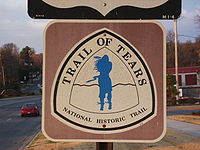Discover Wikipedia using portals
Portal maintenance status: (June 2018)
|
The Indigenous peoples of the Americas PortalCurrent distribution of Indigenous peoples of the Americas The Indigenous peoples of the Americas are groups of people native to a specific region that inhabited the Americas before the arrival of European settlers in the 15th century and the ethnic groups who continue to identify themselves with those peoples. The Indigenous peoples of the Americas are diverse; some Indigenous peoples were historically hunter-gatherers, while others traditionally practice agriculture and aquaculture. In some regions, Indigenous peoples created pre-contact monumental architecture, large-scale organized cities, city-states, chiefdoms, states, kingdoms, republics, confederacies and empires. These societies had varying degrees of knowledge of engineering, architecture, mathematics, astronomy, writing, physics, medicine, planting and irrigation, geology, mining, metallurgy, sculpture and gold smithing. (Full article...) Selected article The Trail of Tears is a name given to the forced relocation of Native American nations from southeastern parts of the United States following the Indian Removal Act of 1830. The removal included many members of the following tribes, who did not wish to assimilate: Cherokee, Muscogee, Seminole, Chickasaw, and Choctaw nations, among others, from their homelands to Indian Territory west of the Mississippi River. The Native Americans who chose to stay and assimilate were allowed to become citizens in their states and of the U.S. The phrase "Trail of Tears" originated from a description of the removal of the Choctaw Nation in 1831. Many Native Americans suffered from exposure, disease and starvation on the route to their destinations. Many died, including 2,000-6,000 of 16,542 relocated Cherokee. European Americans and African American freedmen and slaves also participated in the Chickasaw, Choctaw, Muscogee Creek and Seminole forced relocations. Selected image Wawadit'la, also known as Mungo Martin House, a Kwakwaka'wakw "big house", with heraldic pole. Built by Chief Mungo Martin in 1953. Located at Thunderbird Park in Victoria, British Columbia, Canada image credit: Ryan Bushby
General imagesThe following are images from various Indigenous peoples of the Americas-related articles on Wikipedia.
Selected biography
Juan Diego's visions and the imparting of the miraculous image, as recounted in oral and written colonial sources such as the Huei tlamahuiçoltica , are together known as the Guadalupe event (Spanish: el acontecimiento Guadalupano), and are the basis of the veneration of Our Lady of Guadalupe. This veneration is ubiquitous in Mexico, prevalent throughout the Spanish-speaking Americas, and increasingly widespread beyond. As a result, the Basilica of Our Lady of Guadalupe is now one of the world's major Christian pilgrimage destinations, receiving 22 million visitors in 2010. (Full article...) Did you know…
SubcategoriesRelated portalsThings you can do
Selected panoramaTopics
Recognized content
Featured articlesFormer featured articlesGood articles
Former good articlesDid you know? articles
In the News articlesAssociated WikimediaThe following Wikimedia Foundation sister projects provide more on this subject:
American indigenous language WikipediasAvañe'ẽ (Warani) · Aymar aru (Aymara) · ᏣᎳᎩ (Cherokee) · Chahta (Choctaw) · ᐃᔨᔫ (Cree) · ᐃᓄᒃ (Inuktitut) · Iñupiak · Kalaallisut (Greenlandic Inuit) · Mvskoke (Muscogee) · Nahuatlahtolli · Diné bizaad (Navajo) · Qhichwa Simi · Tsêhesenêstsestôtse (Cheyenne) Indigenous languages in Wikimedia Incubators: Alabama · Blackfoot · Chinook Jargon · Choctaw · Creek · Lakota · Micmac · Mohawk · Nheengatu · Northwestern Ojibwa · O'odham · Shoshoni · Unami-Lenape · Wüne pakina (Mapudungun) · Yucatec Maya · Central Alaskan Yup'ik · Zuni | |||||||||||||||||||||||||||||||||||||



